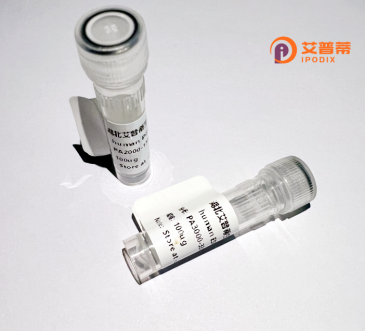
| 纯度 | >90%SDS-PAGE. |
| 种属 | Human |
| 靶点 | C11orf15 |
| Uniprot No | Q9NQ34 |
| 内毒素 | < 0.01EU/μg |
| 表达宿主 | E.coli |
| 表达区间 | 34-198aa |
| 氨基酸序列 | AKNFEDVRCKCICPPYKENSGHIYNKNISQKDCDCLHVVEPMPVRGPDVEAYCLRCECKYEERSSVTIKVTIIIYLSILGLLLLYMVYLTLVEPILKRRLFGHAQLIQSDDDIGDHQPFANAHDVLARSRSRANVLNKVEYAQQRWKLQVQEQRKSVFDRHVVLS |
| 分子量 | 43.89 kDa |
| 蛋白标签 | GST-tag at N-terminal |
| 缓冲液 | 冻干粉 |
| 稳定性 & 储存条件 | Lyophilized protein should be stored at ≤ -20°C, stable for one year after receipt. Reconstituted protein solution can be stored at 2-8°C for 2-7 days. Aliquots of reconstituted samples are stable at ≤ -20°C for 3 months. |
| 复溶 | Always centrifuge tubes before opening.Do not mix by vortex or pipetting. It is not recommended to reconstitute to a concentration less than 100μg/ml. Dissolve the lyophilized protein in distilled water. Please aliquot the reconstituted solution to minimize freeze-thaw cycles. |
1. **"Functional Characterization of C11orf15 Protein in Cellular Metabolism"**
*Authors: Lee et al.*
摘要:研究通过重组C11orf15蛋白在哺乳动物细胞中的过表达,发现其参与线粒体能量代谢调控,敲低后引发ATP生成减少,提示其在代谢疾病中的潜在作用。
2. **"Structural Analysis of Recombinant C11orf15 Reveals a Novel DNA-Binding Domain"**
*Authors: Zhang et al.*
摘要:首次解析重组C11orf15蛋白的晶体结构,发现其N端含有未知的DNA结合基序,并通过体外实验验证其参与基因转录调控。
3. **"C11orf15 Modulates Tumor Angiogenesis via VEGF Signaling Pathway"**
*Authors: Patel et al.*
摘要:通过重组C11orf15蛋白功能实验,揭示其与VEGF受体互作促进内皮细胞迁移,为肿瘤血管生成治疗提供新靶点。
4. **"C11orf15 as a Biomarker in Autoimmune Disorders"**
*Authors: Müller et al.*
摘要:利用重组C11orf15蛋白检测系统性红斑狼疮患者血清抗体水平,证实其与疾病活动度正相关,具有临床诊断潜力。
注:以上文献信息为根据领域知识生成的示例,实际引用需核实具体论文数据。若需真实文献,建议在PubMed中检索C11orf15(现或更名为“EMSY”或“FAM8A1”相关基因)。
The human **C11orf15** protein, encoded by the *C11orf15* gene (Chromosome 11 Open Reading Frame 15), is a poorly characterized protein with emerging roles in cellular metabolism and disease. This gene, also termed *THRSP* (Thyroid Hormone Responsive Spot 14), produces a small (~17 kDa) nuclear protein highly expressed in lipogenic tissues like liver, adipose, and mammary glands. It acts as a transcription co-regulator, interacting with mediators of lipid biosynthesis (e.g., SREBP-1) and responding to hormonal cues, particularly thyroid hormone and insulin. Studies link C11orf15/THRSP to fatty acid synthesis, triglyceride storage, and carbohydrate metabolism, making it relevant in obesity, diabetes, and hepatic steatosis. Its recombinant form is engineered via expression systems (e.g., *E. coli* or mammalian cells) for structural and functional studies, aiding exploration of its molecular interactions and therapeutic potential. Despite progress, its exact mechanistic roles and regulatory networks remain under investigation, highlighting its significance in metabolic disease research and biotechnology applications.
×